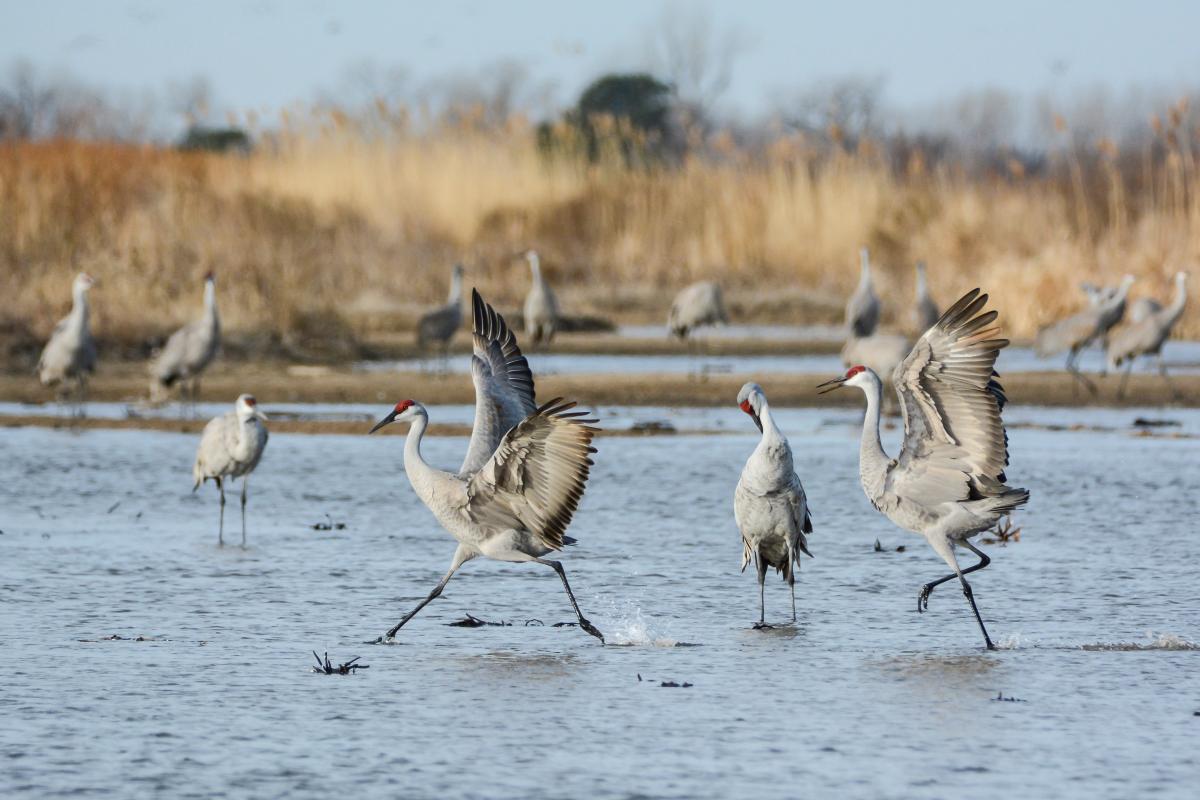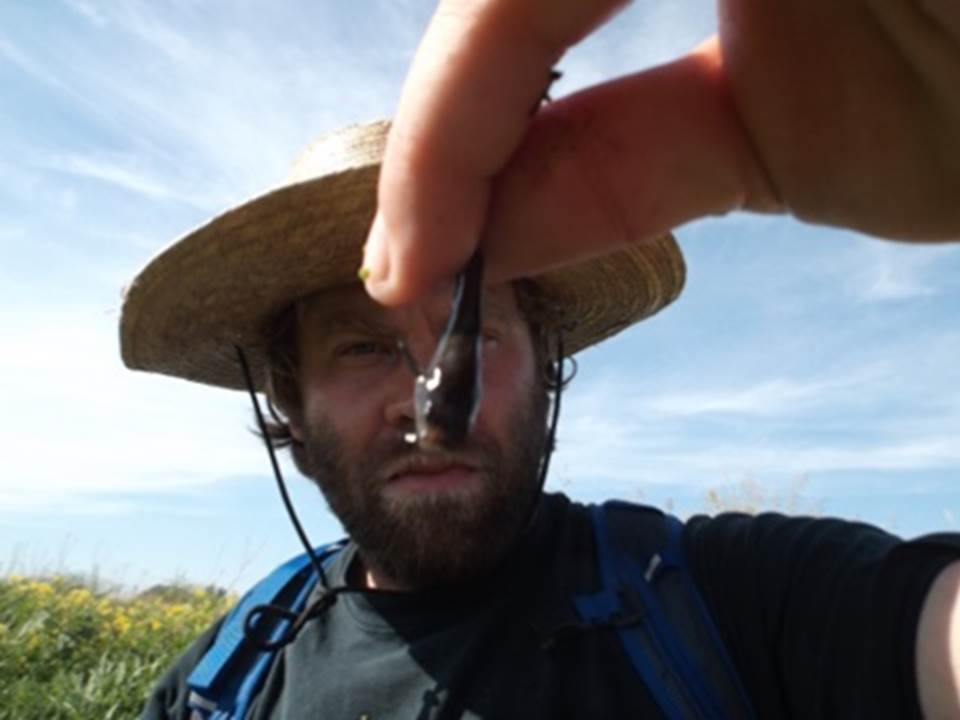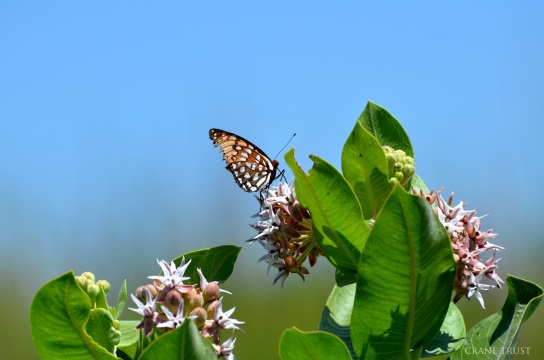Andrew Caven, the director of conservation research at the Crane Trust in Nebraska, spoke to NRT students May 18 about the organization’s latest research and the work being done to protect and restore Platte River habitat for sandhill cranes, endangered whooping cranes and other birds, plants and animals.

About 1.3 million sandhill cranes and 500 of the world’s approximately 800 remaining whooping cranes migrate from Texas and New Mexico to Canada and Alaska through a Nebraska corridor, stopping along the Platte in March to roost and refuel. They have been shifting east in their migration routes, Caven said.
“It’s a landscape transforming, and wildlife have responded,” he said. “So, now we have a big, bifurcated distribution of spring-roosting sandhill cranes. They have basically gone from between Overton and North Platte, and that used to be the epicenter with the highest density.”
Historically, the Platte River and North Platte River from west of Lake McConaughy to Grand Island served as stopover habitat for sandhill cranes, but after dam constructions in the early to mid-1900s, some channels in the Platte narrowed and others dried up completely, he said.
“The places where the Platte was one big channel have become more wooded, more fragmented, more meandering,” he said. “Where there were multiple channels, the Platte data actually fared a little better as, in most cases, a subset of existing channels experienced the largest losses leaving the rest somewhat functional.”
The Crane Trust is in the middle of the current 50-percent migration corridor for whooping cranes, monitoring about 10,000 acres in the Big Bend region in south-central Nebraska.
Trust researchers monitor not only sandhill crane distribution and whooping crane habitat use but also the region’s vegetation, breeding birds, small mammals, rare butterflies like the regal fritillary, fish like the plains topminnow, and channel morphology.

They share their data and findings with universities and other organizations and governmental bodies through their nature center and trails, publications and reports, presentations and trainings, youth education and advocacy work.
They manage the land adaptively, incorporating research findings and simulating natural disturbances, like wildfire and flooding, deemed helpful to wetland species.
“We probably should naturally be on a five- to ten-year fire cycle, but we haven’t been there in a long time,” Caven said.
He and other trust workers use prescribed fire, tree removal, exotic species treatment, bison grazing and one other management technique that locals have come to know them for, river discing.
“We drive tractors up and down the Platte River and disc the soil to simulate the historic floods that used to come through,” Caven said.
The discing prevents sandbars from stabilizing and trees from taking hold, which benefits cranes because they prefer stopping in treeless areas.
“We need to keep those sandbars open so they are good roosting habitat for cranes, and tern plovers and such will also nest on there,” he said.
Studies also indicate a sandhill and whooping crane preference for wet meadows as a foraging habitat.
“When the meadows are wet, that pushes earthworms and other invertebrates to the top, and the sandhill cranes really get after them,” Caven said. “When the meadows are dry, I think it’s a lot harder for them to garner quality food.”
Whooping cranes may eat more animals like frogs in wet meadows. In both cases, such foods provide essential nutrients such as calcium and phosphorus as well as protein.
In the past, people thought whooping cranes, like sandhill cranes, largely depended on waste grain from corn, wheat and barley fields during migration, but more recent studies using long-range cameras near the Platte River have recorded cranes eating diverse fish, frogs and invertebrates.
“When it gets wet and the worms are really moving in late March, it gets insane,” Caven said. “You see sandhill cranes eat worms like fanatics.”
He said the cranes need such protein for physical processes such as injury recovery, muscle function and reproduction.
While managing habitat for the cranes, the Crane Trust also strives to factor in the rest of the ecosystem and recently has been focusing more on regal fritillary butterflies. Caven said these butterflies declined nationally between 75 and 95 percent over the past 20 years.

Crane Trust researchers noted declines on their own lands and researched where regal fritillaries still existed in reasonable numbers. After discovering violets were a top predictor of the butterfly’s presence, the researchers began including violets in prairie restorations. When they found groups of regal fritillaries effectively isolated from each other by thick forest, the researchers cleared the woodland separating pastures with the butterflies. Since then, Crane Trust counts have trended upward from 56 butterflies in 2015 to 280 in 2020.
“We used this to build a habitat model now and we have seen our regal fritillaries increase four years in a row, so it’s not all doom-and-gloom,” he said.
Still, for each intended effect, there may also be many unintended consequences, he said, as appeared when they removed the woodland for the butterflies.
“We cleared the trees, and it worked for regal fritillaries, but then all of the trees started going down,” Caven said.
Beavers, it turned out, also favored the new savanna.
“They went to town and just started clearing the rest of it,” Caven said. “We had to learn to leave a little more up.”
Using such adaptive management strategies, Caven challenged the NRT students to think about a question he and other conservationists often face, “How do you maintain heterogeneity across landscapes when you are significantly constrained by scale?”
He said the Crane Trust conservationists need to leave unburned vegetation for three years for Henslow’s sparrow and regal fritillaries, but they need recently burned and grazed lands for upland sandpipers. They need to have trees basically stripped from near the rivers for whooping cranes, but they also want to maintain habitat for neotropical migrant breeding birds, like Baltimore orioles.
“How do you do that?” he asked. “You do your best. It’s almost impossible, in my opinion, to please every species every year.”
— Ronica Stromberg, National Research Traineeship Program Coordinator


